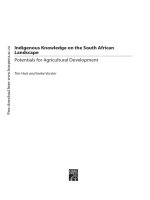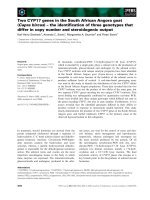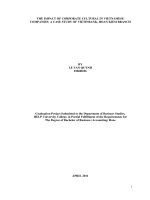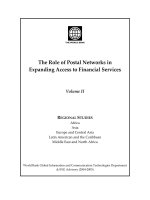THE IMPACT OF THE DIVERSITY CLIMATE ON THE TRANSFER OF TACIT KNOWLEDGE IN THE SOUTH AFRICAN FINANCIAL SECTOR potx
Bạn đang xem bản rút gọn của tài liệu. Xem và tải ngay bản đầy đủ của tài liệu tại đây (446.84 KB, 154 trang )
- Page i -
THE IMPACT OF THE DIVERSITY CLIMATE
ON THE TRANSFER OF TACIT KNOWLEDGE
IN THE SOUTH AFRICAN
FINANCIAL SECTOR
KUBENDRIE LINDA AIYER
A research proposal submitted to the Gordon Institute of Business Science,
University of Pretoria, in partial fulfilment of the requirements for the degree
of Master of Business Administration
November 2006
©
©
U
U
n
n
i
i
v
v
e
e
r
r
s
s
i
i
t
t
y
y
o
o
f
f
P
P
r
r
e
e
t
t
o
o
r
r
i
i
a
a
- Page ii -
ABSTRACT
South African businesses are faced with the immense challenge of transforming
themselves so as to reflect post-apartheid South Africa, while at the same time
remaining competitive within a globalised market. This research project set out
to establish how organisations could effectively channel the potential of an
increasingly diverse workforce to derive positive outcomes for the individual and
the organisation. To this end, the organisational approach to diversity and its
ability to influence the extent of knowledge transfer has been examined.
In fully exploring this relationship, four research propositions were developed. A
quantitative approach in the form of a survey was utilised to ascertain the
perceptions of employees within the banking sector in South Africa. The
qualitative phase of the research entailed in-depth interviews with subject
matter experts within the industry. This was primarily used to corroborate the
survey responses, and to document original thought within the scope of this
research. The data obtained through these research instruments was analysed
to ascertain the strength of the diversity climate and knowledge transfer as
business enablers.
The results revealed that a positive diversity climate yields greater levels of
knowledge sharing, which consequently results in positive career outcomes for
the employee. These factors in aggregate produce both tangible and intangible
benefits for the organisation. A conceptual framework has been proposed that
depicts the key linkages established through the research findings.
- Page iii -
DECLARATION
I declare that this research project is my own work. It is submitted in partial
fulfilment of the requirements for the degree of Master of Business
Administration at the Gordon Institute of Business Science, University of
Pretoria. It has not been submitted before for any degree or examination in any
other University.
KUBENDRIE AIYER
November 2006
- Page iv -
DEDICATION
To my husband, Sandeeran, whose support, encouragement, patience, and
most of all love, had given me the strength to persevere through all those
stressful moments during these two years.
- Page v -
ACKNOWLEDGEMENTS
I would like to extend my sincere gratitude to the following individuals:
̇ My supervisor, Colin Rowley, for his support, encouragement and
guidance on this research project. I am exceptionally thankful for his
assistance.
̇ My friends, Sarita, Vasinthee and Jeetesh for their constant support
throughout the MBA. They have given me strength whenever I needed it.
̇ All my friends and family for their understanding and motivation.
- Page vi -
TABLE OF CONTENTS
ABSTRACT II
DECLARATION III
DEDICATION IV
ACKNOWLEDGEMENTS V
LIST OF TABLES AND FIGURES X
GLOSSARY XIII
CHAPTER 1 – DEFINITION OF THE RESEARCH PROBLEM 1
1.1 Introduction 1
1.2 Motivation for research 3
1.3 Research Problem 8
CHAPTER 2 – LITERATURE REVIEW 9
2.1 The South African Financial Services Industry 9
2.1.1 Introduction 9
2.1.2 Industry challenges and drivers of transformation 9
2.2 Improving organisation strategic performance 12
2.3 Diversity defined 14
2.3.1 The Diversity Climate 16
2.4 Organisational Knowledge 25
2.4.1 Tacit knowledge defined 27
2.4.2 Modes of Knowledge Conversion 28
2.4.3 Knowledge Transfer 29
- Page vii -
2.5. The relationship between employee motivation and knowledge transfer 35
2.6. Organisational benefits from knowledge management processes 37
2.7. The relationship between diversity management and knowledge sharing 38
CHAPTER 3 – RESEARCH PROPOSITIONS 42
CHAPTER 4 – RESEARCH METHODOLOGY 44
4.1 Introduction 44
4.2 Research Paradigm 44
4.3 Quantitative Research Methodology 47
4.3.1 Population of relevance 47
4.3.2 Sampling Method and Size 48
4.3.3 Data Collection 49
4.3.4 Data Analysis 51
4.3.5 Research Limitations 53
4.4. Qualitative Research Methodology 53
4.4.1 Population of Relevance 54
4.4.2 Sampling Method and Size 54
4.4.3 Data Collection 55
4.4.4 Data Analysis 56
4.4.5 Research Limitations 57
4.5 Conclusion 57
CHAPTER 5 - FINDINGS 58
5.1 Introduction 58
5.2 Profile of the sample group 58
5.2.1 Quantitative phase 58
- Page viii -
5.2.2 Qualitative phase 63
5.3 Presentation of findings 65
5.3.1 Research Proposition 1 – The Diversity Climate 65
5.3.2 Research Proposition 2 – The relationship between the diversity climate
and the sharing of
tacit knowledge 76
5.3.3 Research Proposition 3 – The impact of a positive diversity climate and
knowledge sharing on individ
ual career outcomes 85
5.3.5 Research Proposition 4 – Tangible and intangible benefits to the
organisation 87
CHAPTER 6 – DISCUSSION OF RESULTS 93
6.1 Introduction 93
6.2 Research Proposition 1 – Nature of the diversity climate 93
6.3 Research Proposition 2 – The relationship between the diversity climate and the
sharing of tacit know
ledge 98
6.4 Research Proposition 3 – Individual career outcomes 102
6.5 Research Proposition 4 – Tangible and intangible organisational benefits 105
CHAPTER 7 - CONCLUSION 110
7.1 Conceptual model 110
7.2 Recommendations 116
7.3 Future Research 118
7.4 Conclusion 119
REFERENCES 120
- Page ix -
APPENDICES
Appendix 1 135
Appendix 2 136
Appendix 3 137
Appendix 4 138
Appendix 5 140
- Page x -
LIST OF TABLES AND FIGURES
CHAPTER 1
Figure 1.1 – Tacit versus explicit knowledge 7
CHAPTER 2
Table 2.1: Eight ‘S’ Model 13
Figure 2.1: Spheres of Activity in the Management of Cultural Diversity 16
Figure 2.2: Climate for Diversity Model 19
Figure 2.3: Framework relating Workgroup Diversity to Organisational Performance 21
Figure 2.4: Relationship between Cultural Diversity and Work Group Functioning 22
Figure 2.5: Interactional Model of Cultural Diversity 24
Figure 2.6: Ontological Diagram of Organisation Knowledge 26
Figure 2.7: Multidimensional Structure of Tacit Knowledge 136
Figure 2.8: SECI Model Error!
Bookmark not defined.
Figure 2.9: Integrative Framework of factors influencing Knowledge Sharing 32
Figure 2.10: Influences of Cultural Diversity on Management 40
CHAPTER 4
Table 4.1: A Comparison between Quantitative and Qualitative Research 45
CHAPTER 5
Table 5.1: Organisational affiliation of the sample group 58
Figure 5.1: Race profile of respondents 59
Figure 5.2: Job category representation 60
Figure 5.3: Job segmentation per race group 60
Table 5.2: Gender representation 61
Figure 5.4: Split of gender by race 61
- Page xi -
Table 5.3: Tenure in organization 62
Figure 5.5: Tenure by race split 62
Figure 5.6: Education level of respondents 63
Table 5.4: Organisational affiliation and designation of the sample group 64
Table 5.5: The diversity climate – Individual-level experiences 66
Figure 5.7: Responses to Q12 67
Table 5.6: Factors that could improve the diversity climate – Individual experiences 67
Table 5.7: Organisational effort/ initiatives 68
Table 5.8: The diversity climate – Group dynamics 68
Figure 5.8: Responses to Q17 69
Table 5.9: Factors that could improve the diversity climate – Group dynamics 69
Table 5.10: Organisational effort/ initiatives 70
Table 5.11: The diversity climate – Management support 70
Figure 5.9: Responses to Q15 71
Figure 5.10: Responses to Q23 71
Table 5.12: Factors that could improve the diversity climate – Management support 72
Table 5.13: Organisational effort/ initiatives 72
Table 5.14: The diversity climate – Training and development 73
Figure 5.11: Responses to Q18 73
Table 5.16: Organisational effort/ initiatives 74
Table 5.17: The diversity climate – Policies and procedures 75
Table 5.18: Factors that could improve the diversity climate: Policies and procedures 75
Table 5.19: Organisational effort/ initiatives 76
Table 5.20: Knowledge sharing in the banking sector 76
Table 5.21: Correlation between individual experiences and knowledge sharing 78
Figure 5.12: Relationship between Q12 and Q27 79
Figure 5.13: Relationship between Q14 and Q27 80
- Page xii -
Table 5.22: Correlation between group dynamics and knowledge sharing 81
Table 5.23: Correlation between management support and knowledge sharing 82
Table 5.24: Correlation between training and knowledge sharing 82
Table 5.25: Correlation between formal initiatives and knowledge sharing 83
Table 5.26: Barriers to Knowledge sharing 83
Table 5.27: Enablers of knowledge sharing 84
Table 5.28: Personal career outcomes 85
Figure 5.14: Responses to Q40 86
Table 5.29: Interview results: Personal Career outcomes 87
Table 5.30: Compliance to legislation: Human Resource Development 88
Table 5.31: Skills and competency transfer 89
Table 5.32: Process efficiency 90
Table 5.33: Increased competitiveness 91
Table 5.34: Work environment 92
CHAPTER 7
Figure 7.1: Model depicting the linkages between business enablers and business
outcomes 111
- Page xiii -
GLOSSARY
BANKSETA The Banking Sector Education and Training
Authority, has a responsibility to enhance the
skills and competence of employees within the
sector, by supporting and facilitating skills
development strategies.
Psychological Contract Rousseau (2004a) defines the psychological
contract as beliefs, based upon promises
expressed or implied, regarding an exchange
agreement between an individual and, in
organizations, the employing firm and its agents.
The belief by employees that a future return has
been promised by the employer creates certain
expectations amongst employees. These
expectations could be extrinsic in nature or in the
form of career development.
Organisational Citizenship The key elements shared by various definitions
of Organisational Citizenship behaviour is that it:
̇ Represents behaviour above and beyond
those formally included in the organisational
contract
̇ Is discretionary in nature
̇ Is not directly or explicitly rewarded
Is important as a contributor to organisational
effectiveness (Netemeyer, Boles, McKee and
McMurrian, 1997)
Customer Life-Time Value This refers to the profitability that could be
derived from a customer, if the customer remains
with the organisation for his/her entire life.
Mean A mathematical average of the data (responses)
obtained.
Median This is the middle observation when the data are
listed from the smallest to largest response.
Mode The most frequently occurring response.
- Page 1 -
CHAPTER 1
DEFINITION OF THE RESEARCH PROBLEM
1.1 Introduction
‘The challenge facing South Africa today is for managers to harness the richness
of many ethnic groups so as to enhance productivity and facilitate global
competitiveness’ (Thomas and Bendixen, 2000).
As South Africa takes its place in a geopolitical landscape, it is confronted with
new and better global opportunities, and a world that is characterised by a plethora
of networks, where technical and human links continually change (Esterhuyse,
2003). However, transformation which is described as a ‘strategic response to the
condition in which an organisation [or country], cannot continue functioning as
before’, (Levy and Merry, 1986, ix), has a two-fold connotation for a country such
as South Africa.
If South Africa were to be contextualised within the United Nations Development
Programme hierarchy of indicators for transformation, see Appendix 1, one would
find a country anxious to attain a state of ‘International Comparability’, while
simultaneously building its young democracy, and transforming the economy away
from its legacy of racial discrimination and national domination (United Nations
Development Programme, 2000). In this regard, it becomes imperative that the
‘Community, Provincial and National level’ transformation be prioritized within the
short-term, before a sustainable global presence is sought. According to Msweli-
- Page 2 -
Mbanga and Potwana (2005), ‘the system of democracy cannot be confined at the
political level. For democracy to survive, it must occur and function in all social and
economic organisations including the workplace’. To this end the South African
government has attempted to create employment opportunities, empower the
historically oppressed and remove discrimination in the workplace (United Nations
Development Programme, 2000), by passing several Acts. These include the
Employment Equity Act of 1998, the Skills Development Act of 1998, the
Promotion of Equality and Prevention of Unfair Discrimination Act of 2000, and the
Black Economic Empowerment Act of 2003. In addition, charters have been
conceded to, that govern the various sectors within the South African economy.
This includes the Financial Sector Charter (FSC) that attempts to address past
disparities (National Treasury, 2003), particularly in the areas of Procurement,
Ownership, Corporate Social Responsibility, Access to Finance, and Human
Resource Development.
These local interventions, coupled with the emerging trends of globalisation, mean
South African businesses are faced with the immense challenge of transforming
themselves to be reflective of the post-apartheid South Africa, while remaining
competitive within the global marketplace.
Perez and de Pablos (2003) argue that given the intensity of competition and the
unprecedented rate of technological change in the current entrepreneurial
environment, tangible assets in terms of physical and financial capital, can no
longer provide a sustainable competitive advantage. It is intellectual capital or
‘people-embodied know-how’ that distinguishes leaders in the market (Prahalad,
- Page 3 -
1983). Prahalad and Hamel (1990) later added that the ability to build on the
inherent value of these intangible assets constitutes a core competency for
organisations, particularly those providing financial and professional services. As
such, in the words of Ulrich (1991), ‘given the fact that employee knowledge, skills
and abilities constitute one of the most significant and renewable resources which
a company can take advantage of, the effective management of this capital now
has greater importance than ever’.
1.2 Motivation for research
Within the South African context, the effective management of intellectual capital
comes with inherent challenges. Firstly, the new operating reality includes a
diverse workforce, particularly in terms of cultural and ethnic backgrounds. Given
that there is empirical support for the fact that culturally diverse work teams are
able to attain higher levels of profitability than their culturally homogenous
counterparts, there is a ‘need for organisations to espouse a comprehensive
approach to valuing diversity’ (Ng and Tung, 1998, p992). According to Burgess
(2002), the remnants of apartheid are still evident in the way that ‘people of
different races continue to live essentially separate lives’ (p5).
The second challenge is that the South African government has identified the
shortage of suitably skilled labour as the single biggest threat to the successful
implementation of the Accelerated and Shared Growth Initiative for South Africa
(Asgisa) (I-Net Bridge, 2006). This however, is not a recent development. It is an
- Page 4 -
issue that has its roots in the country’s history of racial separation, and has been
the focus of many discussions in recent years.
Sello Moloko, who is at the helm of the Association of Black Securities and
Investment Professionals (Absip), and who has played a key role in the drafting of
the Financial Sector Charter, asserts that this country will not be able to achieve
sustainable higher growth without skills. People who can operate on the ground
are required, and at present, the financial sector [in particular], has not made a
great deal of effort in skills development. New ways to accelerate skills must be
sought (Louw, 2005). Absip Deputy President, Nomkhita Nqweni, reaffirmed this
statement by declaring that for meaningful transformation, and sustainable
economic empowerment, financial institutions need to focus on pillars of
empowerment related to internal transformation, such as people and skills
development. An enabling environment needs to be created to allow
inexperienced professionals to grow in their organisations, and thereby progress to
senior and executive levels (Bridge, 2005).
A study conducted by the Absa Bank Group in 2002 found that the unemployment
rate in the country, which was already around 40 percent, was increasing by 1.8
percent per year. One of their primary recommendations in counteracting these
conditions, was that a sharp increase in skills and productivity levels was needed
(Van Tonder, 2002). Freeman (2006) contends that ‘while there are political
sensitivities about bringing highly skilled emigrants and retirees back into
mainstream employment in South Africa - because these will more often than not
be white people - there is a growing realisation that this is a critical step in
- Page 5 -
accelerating and sustaining economic growth’. He further adds that this is not
meant to undermine black economic empowerment initiatives, but rather to
‘harness whatever high-end skills and resources are available to us to uplift the
broader base of the population’ (p1).
Rijamampianina and Maxwell (2002), declare that it has become a critical
managerial objective that new employees be integrated into the mainstream
business, and that the skills of existing, lower-level employees be developed, as a
priority, to enable the broad spectrum of cultural groups to function together in a
cohesive and productive manner. To this end, the sharing of knowledge and
experiences that veteran employees have acquired over time, is key to bridging
the skills and competency gap that could exist within a diverse workforce, that still
bears the effects of past educational disparities. In so doing, it was Robert (2000,
p429) who suggested that social and cultural influences must be taken into
consideration before such initiatives are promulgated. He contends that knowledge
sharing will be more successful when ‘it is between agents who share common
social, cultural and linguistic characteristics. It will be less effective when agents
are from diverse backgrounds, particularly in the early stages of interaction. Over
time though, they will develop an appreciation of their partner’s social context.
Together they will establish their own social norms and expectations of one
another, thereby enabling the successful exchange of knowledge’.
There are two business imperatives that emerge as a result of the above. The first
is that organisations need to inculcate a climate that supports diversity (Morosini,
1998), as early as possible and at every juncture. A workforce that reflects an
- Page 6 -
increase in the number of women, minority groups, individuals with ethnic
backgrounds, ageing employees, and people from different cultures, will need to
work together towards common organisational goals despite their diversity
(Dutton, 1998).
The second imperative emanates from Koskinen (2003), who states that although
the success of an organisation may accrue from either explicit (codified) or tacit
(personal) knowledge, many organisations do not sufficiently understand this
‘bipartite nature of knowledge’, and as such ‘attention is often directed on codified
material only. The fact that a great deal of the know-how required in
implementation of a task is tied to knowledge that is not written, is not taken into
consideration as a whole’ (p67). When employees retire or leave the organisation,
this knowledge is permanently lost.
The sharing of tacit knowledge in particular is paramount as approximately 70
percent of what an employee needs to know to do his or her job successfully is
learned outside of formal training (Kaplan, 2002). A survey conducted by The
Delphi Group revealed that there is a clear understanding across industries that
the tacit knowledge base can account for as much as 75% of an organisation’s
collective knowledge. The study also found that on average, organisations believe
42% of corporate knowledge is housed exclusively within the brains of employees
(Kothuri, 2002). Figure 1.1 indicates the proportion of tacit versus explicit
knowledge typically characteristic of any organisation. Tacit knowledge has
become a strategic asset that is relevant to sustaining business performance and
overall competitiveness (Pathirage, Amaratunga and Haigh, 2005).
- Page 7 -
Figure 1.1 – Tacit versus explicit knowledge
According to Prahalad and Hamel (1990), Financial Services is one of the more
knowledge-intensive sectors. This sector, within the South African context, is thus
the primary focus of the study. Despite its reliance on knowledge, a lack of skills is
still one of the key challenges facing the industry on a daily basis, according to the
South Africa Banking Survey 2004. In particular, the attraction and retention of
skilled staff, shortage of skills in respect of previously disadvantaged groups, the
standards of skills and the continuous process of upgrading staff skills are the
primary concerns (KPMG, 2004).
In the face of these challenges, have banking institutions in South Africa identified
the business imperatives that have emerged, and if so, how effective have they
been in creating a climate that supports diversity and the transfer of tacit
knowledge?
Source: Adapted from Bartholomew (2005)
- Page 8 -
1.3 Research Problem
This study thus sets out to assess the diversity climate within each of the
participating financial institutions and establish whether:
1. Employees within the financial sector in South Africa will perceive the
diversity climate within their organisations positively.
2. A positive diversity climate is a mediating factor in ensuring more effective
transfer of tacit knowledge in organisations.
3. The sharing of tacit knowledge and skills within a diverse workforce will
result in more positive career outcomes for the individual.
4. Positive career outcomes resulting from the transfer of tacit knowledge, will
produce tangible and intangible benefits for South African financial
institutions.
The final outcome of this research is the derivation of a conceptual framework,
which depicts the linkages between these variables.
The following terms have been used interchangeably within this research paper:
̇ Knowledge-sharing and knowledge transfer (this refers specifically to tacit
knowledge)
̇ Financial sector and banking sector
̇ Survey and questionnaire
̇ Question and statement
Chapter 2 reviews literature that is relevant to the variables being explored within
this research.
- Page 9 -
CHAPTER 2
LITERATURE REVIEW
2.1 The South African Financial Services Industry
2.1.1 Introduction
The landscape of the financial services industry has metamorphosized as South
Africa’s re-entry into the global arena ushered in new challenges. Within the new
operating environment, the tempo of technological, social and economic change is
accelerating, interdependency is increasing, and uncertainty and complexity are
commonplace. The BANKSETA confirms that there are a variety of factors driving
change in the South African Banking Sector. The sector’s ability to complete
globally depends on the effectiveness of its people at all levels, and dictates a
continual emphasis on the acquisition of knowledge and skills in the face of these
changes (BANKSETA, 2004).
2.1.2 Industry challenges and drivers of transformation
• Market share and the competitive environment
The industry is relatively concentrated in terms of market share of assets, but not
out of line with other developing nations (National Treasury and South African
Reserve Bank, 2004). The highly competitive environment is exacerbated by the
entry of foreign and niche banks, and increased commoditisation of service
offerings. This implies that the traditional ways of conducting business may not be
- Page 10 -
effective, and thus new business models need to be developed to provide a
competitive advantage (Arevuo, 2003).
• Labour market and productivity
While the banking sector mirrors global trends in reducing the number of
employees, productivity levels need to be increased. There is a growing need for
highly skilled people, particularly in specialised areas of the bank (BANKSETA,
2004). The high levels of unemployment and poverty in the country, coupled with
the growing impact of the HIV/AIDS pandemic, further exacerbate the shortage of
skilled labour and hinder broader participation of economically active individuals
within the mainstream economy (Lehutso-Phooko, 2004). This impacts directly on
the profitability and competitiveness of the financial sector. The sector is unable to
exploit the demographic dividend offered by a relatively young population structure
(Lehutso-Phooko, 2004).
• Legislative environment
The banking sector is highly regulated, with the Financial Sector Charter being one
of the most significant compliance issues. This charter is a commitment to Black
Economic Empowerment (BEE) within the financial services sector. It establishes
mechanisms for BEE, by setting targets in the categories of Human Resource
Development, Procurement, Access to Financial Services, Empowerment
Financing, Ownership and Control, and Corporate Social Investment. The
signatories believe the Charter will be a key driver of sustainable growth,
redressing social and economic inequalities in South Africa, while providing a
sound policy framework for the future development of the industry. It is hoped that
the Charter will underpin sound business practice, as well as maintain the strength
- Page 11 -
and stability of the financial sector (Banking Council of SA, 2004). Compliance is
one of the key drivers of transformation within the industry.
• Knowledge Management
- At a juncture where the pace of change within the sector has accelerated,
experienced employees either take on new roles or leave the organisation. As
a consequence, remaining employees often lack general knowledge about the
way things work (Trudell, 2002). The results of a survey conducted by
Accenture in the United States found that organisations are failing to capture
critical workforce knowledge and experience from employees facing retirement.
26% of respondents stated that their organisations will let them retire without
transfer of knowledge, and 44% said that their knowledge-transfer process will
range from one to two weeks to simply an informal discussion (Tantri, 2005). A
similar situation exists in the South African banking environment, where
employee turnover is high, but the harvesting of knowledge is limited
(PricewaterhouseCoopers, 2002).
- The negative implication of organisational change is that employees naturally
feel insecure for fear of job loss. Within such a context, it becomes difficult to
encourage a culture of knowledge-sharing (Trudell, 2002).
- Arevuo (2003) stated that financial service companies tend to view money as
the ‘panacea for a multitude of problems’ (p2), therefore the assumption is that
if employees do not embrace knowledge-sharing, building in a financial
incentive would produce the desired behaviour. However, he contends this is
but a short-term solution. In addition, Arevuo (2003) stated that organisations
within this sector reward and recognise individual achievement as opposed to
team performance.
- Page 12 -
- Tacit knowledge is intangible and often embedded within the minds of people.
As a result, it is relatively unexplored and not fully understood (Pathirage,
Amaratunga and Haigh, 2005). The tendency is therefore, to focus on explicit
knowledge, as the transfer thereof is highly visible and can be easily
measured.
2.2 Improving organisation strategic performance
According to Higgins (2005), the significant changes occurring so frequently within
the business environment, necessitates the adjustment or change of strategies
more so than in the past. Changes in strategy do not occur in isolation; it is
essential therefore to ensure that the other key organisational factors are aligned
to the strategy. This has become a tremendous challenge to many organisations.
Higgins (2005) proposes an ‘eight S model’, described in Table 2.1, that builds on
the McKinsey ‘seven S model’.
In improving ‘Strategic Performance’, Higgins (2005) posited that the other seven
elements need to be perfectly aligned. However, he acknowledged that this is
often not the case, primarily due to change leaders either not recognising the need
for alignment to the strategy, or because they do not fully understand the
implications of this required alignment. According to Kaplan (2005), economists
and business strategy scholars tend to focus on the more tangible and measurable
hard “S’s” of strategy, structure and systems. The other intangible, more difficult-
to-measure soft “S’s” are usually regarded as social sciences (p42).









